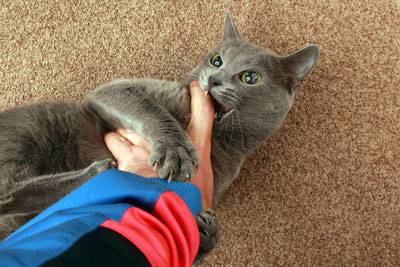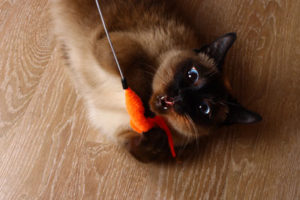The key is to not use your hands or feet as toys.
“There is something about the presence of a cat that seems to take the bite out of being alone.”
—Louis J. Camuti, author of “All My Patients Are under the Bed: Memoirs of a Cat Doctor”
But what if your favorite feline is a biter? It can be quite shocking when you’re relaxed, stroking your cat and he suddenly bites your hand.
Read more about our unique Cat Training course.
About Cat Bites

©photosaint/Adobe Stock
Cat bites are dangerous by design. Anatomically, their canine teeth are sharp little fangs, designed to kill and shred small prey. Biologically, they can be just as hazardous. Cat saliva contains myriad bacteria, some of which are problematic for humans such as Bartonella henselae (the causative agent of cat scratch disease) and Pastuerella, which can cause skin and lymph node infections.
This is why a cat bite should be taken seriously. A trip to the doctor and a round of antibiotics can solve most issue; however, if the bite is a deep puncture, further action might be required. It’s also why you should be very motivated to stop your cat from the habit of biting.
Identify the Reason
As I’ve said in previous articles, cats don’t do things without a reason. Every action they take has intent. Fortunately, it can be fairly easy to identify the motive behind a bite.
- Pain: Felines typically hide pain for as long as possible. As a result, they can become easily aggravated and bite when touched. A checkup from your veterinarian is always in order if your cat begins biting when she didn’t before.
- Fear: If your cat is frightened, she might respond with a bite if you try to handle her. This is why you should never reach out to a scared animal.
- Play: In most cases, owners have taught their cats that biting is a part of play. Playing too rough or too long with your cat can encourage her to bite, especially if you use your hands or feet as “toys.” This is why it’s so important to teach your cat appropriate play.
Games We Play

©zsv3207/Adobe Stock
I learned the hard way that the worst game you can teach your cat is “bed mice,” where you move your hand or foot under a sheet, which your cat then tries to catch and kill. Sadly, it’s also an incredibly fun game for both people and cats. Why is this a bad game? Because you’ve now taught your cat that things under sheets must be destroyed. This bodes ill for toes (and other body parts) that might move in the night or morning, when crepuscular cats are most alert. Never teach your cat a game that involves your body becoming a target; this includes waggling your fingers or toes at kittens.
In order to teach your cat not to bite, you will need to provide her with alternative ways to express her hunting instincts. You will also need to make sure you do not overstimulate your cat to the point where she has to bite in order to get you to stop. Learn to read your cat’s body language so that you can tell when she’s had enough petting, brushing or cuddling. Laid-back ears, dilated pupils and/or a twitching tail are all signs that your cat is becoming overstimulated.
Redirection

©detry26/Adobe Stock
Working with cat is similar to being a magician: redirection is your best tool. In the cat world, redirection involves providing plenty of things for your cat to play with besides your hands or feet: puzzle toys, stuffed mice, catnip toys, balls, interactive toys (such as a track ball) paper bags, boxes, etc.
In addition to having plenty of solo toys to play with, your cat should also have daily playtimes with you; a minimum of two 15 minute sessions every day. A rousing game of chasing the wand toy or pouncing on cat bubbles will enable your cat to expend excess energy so she can eat and sleep properly, and not engage in destructive behavior.
Some cats engage in stalking activity, such as hiding under a bed or behind a door and attacking when someone walks by. For cats, this is a perfectly natural way to hunt and play. For humans, it’s not nearly as fun of a game. If you know your cat is behind a door or under a bed, use a wand toy or roll a ball to lure her into attack. It’s just as much fun for the cat and not nearly as destructive for you.
Don’t Act Like Prey
Finally, if you don’t want to be prey, you can’t act like prey. Never run from your cat; this almost always results in a chase. Don’t use your hands to redirect your cat if, for example, she is “bullying” another pet. Distract her with a wand toy or sudden, intriguing noise, such crinkling paper or the jingle of a stuffed toy.
While redirecting a cat can take time, it’s well worth the effort. Cats are quick learners and with proper motivation, you will a harmonious home and bite-free extremities.





